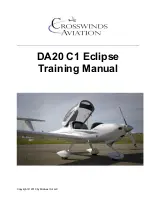
FSD International
Commander 115 TC
Pilot Operating Handbook
- 45 –
Copyright© 2008 by FSD International. All rights reserved.
For use with Microsoft Flight Simulator only. Not to be used for real-world aviation.
6 Airplane and Systems Descriptions
This section provides a description of the airplane and its systems.
6.1 GENERAL
The Model 115 TC is a four place, low wing, all-metal, retractable gear airplane powered by a six
cylinder, turbocharged, fuel injected Lycoming engine that is equipped with a McCauley all-metal
three blade, constant speed propeller. Access to the cabin is through two lockable cabin doors, one
on each side of the airplane and a lockable baggage door on the left side of the fuselage. The cabin
interior is provided with four seats. The airplane is equipped with a retractable tricycle landing gear
system and incorporates a steerable nose wheel and toe-operated hydraulic disc brakes.
6.2 AIRFRAME
FUSELAGE
The fuselage consists of the nose section, center section and aft section. The nose section,
extending from fuselage station 22.00 to 62.50, houses the powerplant and retractable nose
landing gear. Nose landing gear doors, which open and close as the gear is extended or retracted,
form an aerodynamically smooth nose section during flight.
The nose section is joined to the center fuselage section at fuselage station 62.50, which is also the
location of the engine firewall. The center fuselage, which contains the main cabin area and
baggage compartment, extends from fuselage station 62.50 to 178.00 where it is jointed to the aft
fuselage section. The center fuselage section houses the seats for pilot and three passengers, and
has two doors that afford access to the airplane from either side.
The pilot area is equipped with a wide-vision windshield and large door windows.
The aft fuselage section, extending from fuselage station 178.00 to 263.00, is permanently secured
to the center fuselage section and provides structural attachment points for the empennage tlight
surfaces and controls. This section houses the battery, hydraulic power pack unit and various
control surface cables. Aluminum flooring supported by longitudinal beams and bulkheads extends
from the firewall aft through the baggage compartment. The center wing structure is attached to
the fuselage so that a part of the wing torque is absorbed by the fuselage structure. The aft tail
cone is capped by a stinger containing mounts for a tail navigation light and optional strobe light.
WINGS
Each wing is of all-metal stressed-skin construction incorporating spars, formed ribs and an integral
fuel tank contained in a three-rib section, forward of the main spar. The main spar of each wing is
joined together at the center of the fuselage with spar cap splices.
The wing is installed in the lower center fuselage section. It is secured to the fuselage load-bearing
frames and fittings by bolts and nuts at stations 85.00, 123.00 and forward of station 148.00.
Access plates located at various points on the lower skin of the wing provide access for inspection
and repair of the fuel system and the flight control cabling. Landing gear fitting/retraction
mechanisms are installed in the basic wing structure to provide attach points for the main landing
gear.















































